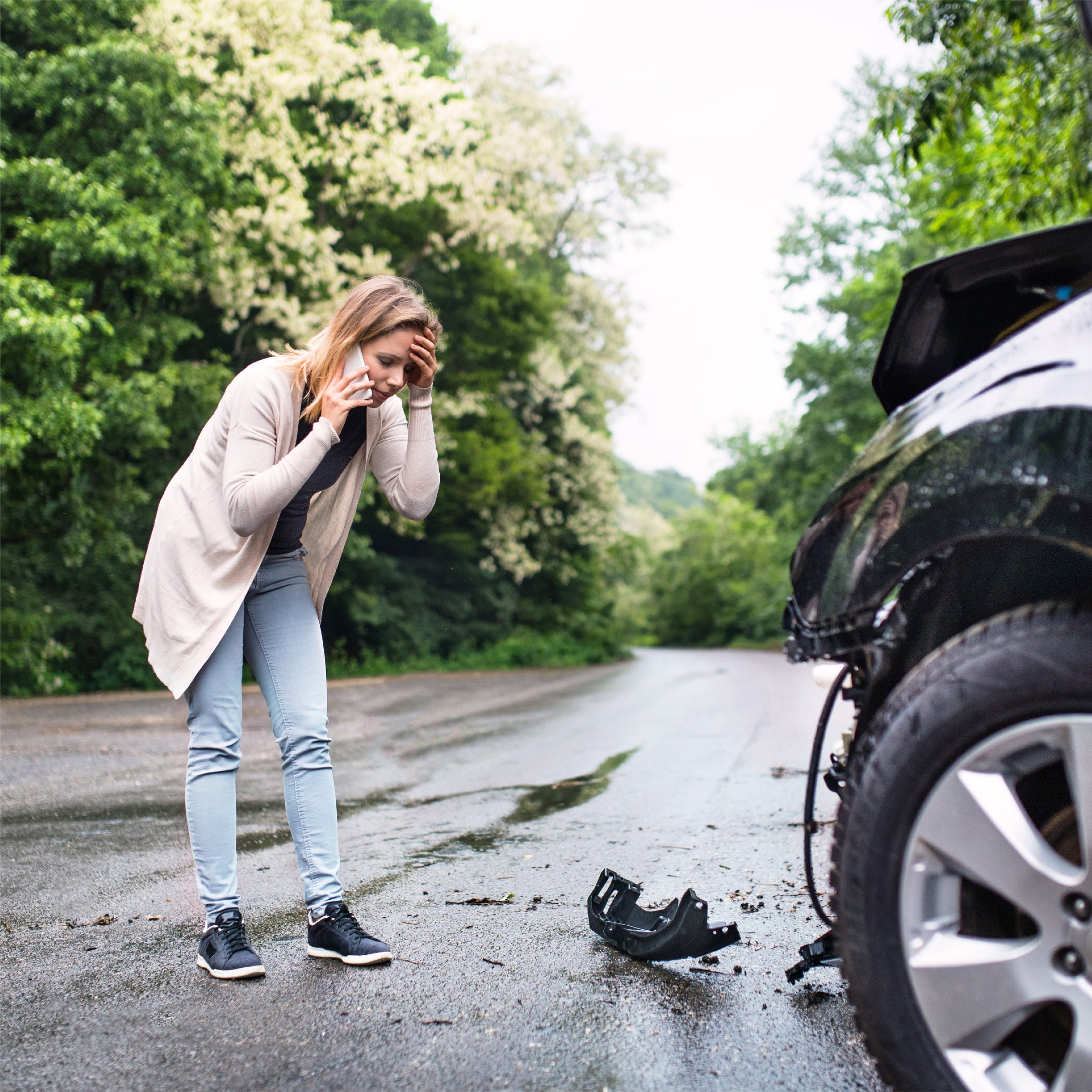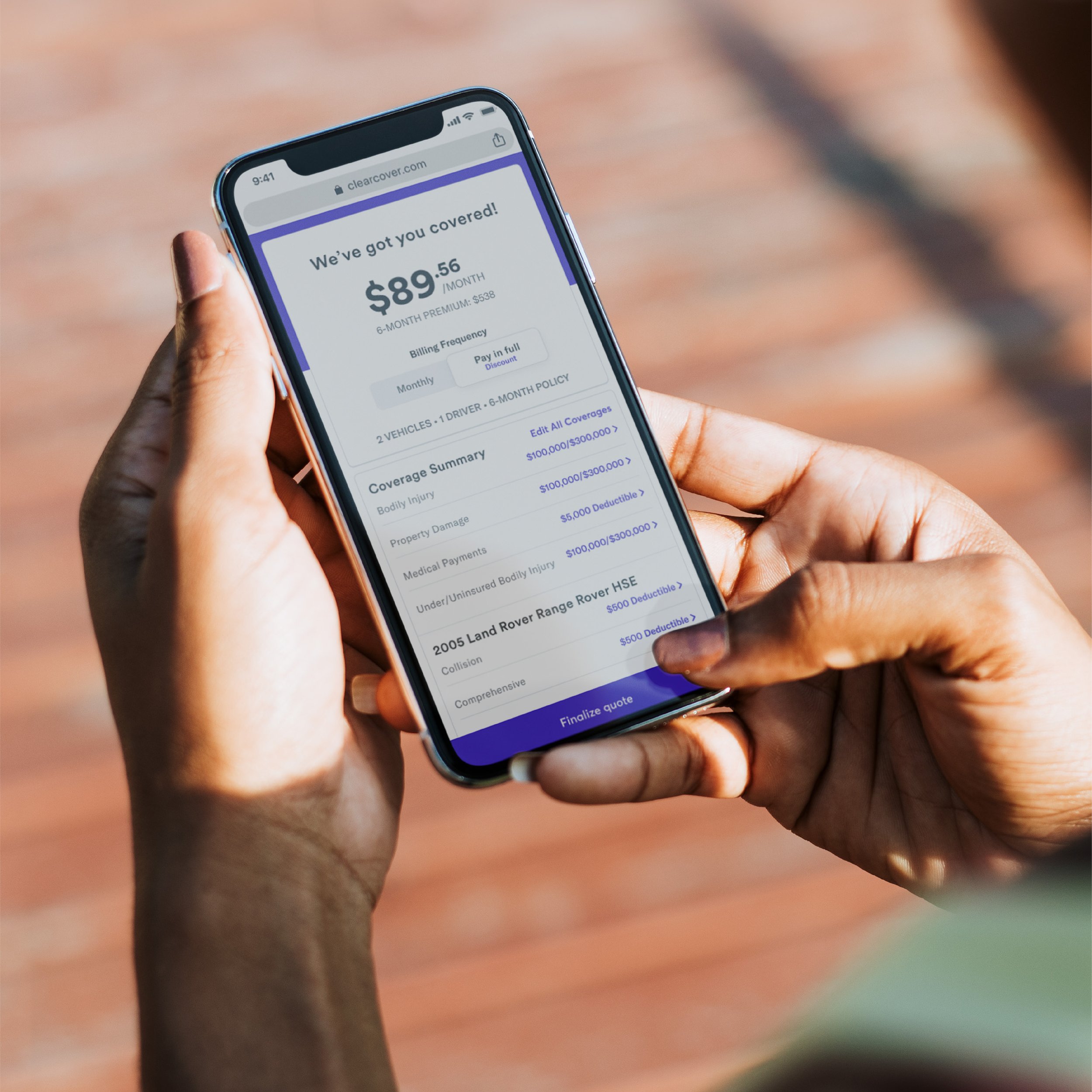Your Guide to Buying Car Insurance for the First Time
Written by Team Clearcover
Buying car insurance for the first time can feel a little intimidating. Whether you’re aging off your parents’ car insurance policy, are new to the United States, or have recently gotten your driver's license for the first time, selecting the right car insurance coverage can be a challenge at first.
Lucky for you, we’re here to help. In this article, you’ll learn how to buy car insurance for the first time and what coverages you should consider to make sure you’re protected on the road.
How to Buy Car Insurance for the First Time
Purchasing car insurance is easier than you think, especially once you have a better idea of what you need. First, you’ll need to gather some important information to get a few insurance quotes. From there, you can compare your quotes to determine the policy that’s best for you.
Step 1) Gather Personal Information and Essential Vehicle Info
When you’re looking to buy car insurance, there’s essential information you will need to provide in order to get an insurance quote.
An insurance quote is essentially an estimated cost for an insurance policy that’s based on the details you provide and the amount of coverage you select.
A lot goes into estimating your car insurance quote, so here is some of the information you’ll want to have on hand:
Driver’s license number
Driving history, including if you’ve had previous accidents
Insurance history (if you’ve been insured before)
Length of your regular commute
Vehicle Identification Number (or VIN)
Make, model, and year of your vehicle
Estimated annual mileage for your vehicle
Step 2) Get Insurance Quotes
Once you’ve gathered the essential information, it’s time to get a quote. You can get a car insurance quote online or through an insurance agent.
With Clearcover, getting an online quote is super quick and easy. Our quote technology shortens the time you’d spend entering all your details, so you can see your price and get to comparing quotes faster.
After providing the necessary information, you will select the types of coverage you want to be included in your policy.
Here’s a quick overview of some common types of coverage:
Liability Coverage: Almost every state in the U.S. requires drivers to carry liability coverage. This coverage consists of two parts: bodily injury and property damage.
Comprehensive and Collision Coverage: While this coverage is usually not required by your state, your car loan or lease may require it. But even if it’s not required, comprehensive and collision coverage can help pay to repair or replace your car if it’s damaged in a covered event, so many drivers choose to carry it.
Personal Injury Protection Coverage: This coverage can help pay for medical expenses if you are injured in a car accident. Some states may require this coverage and what is covered under this coverage will vary by state.
Uninsured or Underinsured Motorist Coverage: This coverage can help protect you if you’re in an accident with a driver who is uninsured or underinsured. It’s required in some states.
Optional Add-On Coverages, like Roadside Assistance and Alternate Transportation: Optional coverages, such as Clearcover’s Roadside Assistance or Alternate Transportation coverages, can help with paying for surprise expenses, like getting locked out of your vehicle or needing a rental car if your vehicle is undrivable after a covered accident.
Your state’s laws set the minimum amount of required coverage and coverage types you must carry, but any additional coverage amounts you select should depend on your individual needs and circumstances.
It’s important to understand the state minimum is just that—the bare minimum. If you get in a high-cost car accident, often the minimum won’t be able to cover all of the expenses, leaving you financially liable for any remaining costs not covered by your insurance policy.
If you prefer to buy insurance in person or over the phone, an insurance agent can help you compare quotes from multiple car insurance companies. You can also get multiple quotes online from sites like The Zebra, Insurify, or Compare.com, and an agent can help you compare the quotes and answer any questions you may have throughout the buying process.
Step 3) Compare Quotes and Select Your Policy
When shopping for insurance, it’s recommended that you get quotes for similar coverage selections from at least a few different insurance companies.
It’s practically impossible to know how prices compare without having a few different quotes for the same coverage selections.
To get a better understanding of how to compare car insurance quotes when buying car insurance for the first time, imagine the following scenario:
CJ is 22 years old, has a squeaky-clean driving record, and will no longer be included as a driver on his parents’ policy. He has recently graduated from college and is purchasing car insurance on his own for the first time.
To compare his options, he gets three car insurance quotes for the following coverage selections:
Bodily injury liability up to $100K per person, $300K per accident
Property damage liability up to $100K per accident
Uninsured motorist bodily injury up to $100K per person, $300K per accident
Uninsured motorist property damage up to $25K per accident with a $250 deductible
Important note: The coverage selections and premiums in this example are illustrative and may not be representative of actual limits or prices offered by an insurer in your state.
CJ receives the following quotes from three different companies:
Insurance Company A: $88 per month
Insurance Company B: $73 per month
Insurance Company C: $79 per month, and this policy includes add-on Roadside Assistance and Alternate Transportation coverages
While Company C is slightly more expensive than Company B, CJ might find Company C better fits his specific insurance needs.
With Company C, not only will CJ have the coverages he selected, but he’ll also have peace of mind that if he’s ever stuck on the side of the highway due to a bad battery, or if he needs a rental car because his car is undrivable due to a covered accident, his insurance will be there to help.
Do First-Time Drivers Pay More for Car Insurance Coverage Than Experienced Drivers?
First-time drivers generally pay more for car insurance coverage. If you’re a first-time driver, you may be considered a higher risk to insure, as you’re still building your driving record.
A driver’s risk is based on many different factors, including driving history. The lower risk a driver is considered, the more likely they are to have lower premiums.
But if you’re a new driver, don’t worry—you’ll get tips on how to get more affordable car insurance later in this article!
How Much More Do New Drivers Have to Pay for Car Insurance?
Brand-new drivers may pay more per year in premiums than experienced drivers with a longer driving history.
If you’re not a new driver—and you’re simply buying a car insurance policy for the first time—you may already have a driving history if you were previously on someone else’s policy, such as your parents’ insurance.
If you are a first-time driver, keep on driving safely, and you’ll likely be on your way to a more affordable car insurance premium in the future.
How to Buy Affordable Car Insurance for First-Time Drivers
Now let’s go over some ways to buy affordable car insurance for a first-time driver or first-time car insurance buyer.
It’s important to note that the cheapest car insurance doesn’t always provide you with the coverage that will best fit your needs. If you’re not sure where to start, a Clearcover insurance agent can talk through your options with you and help make sure you’re comfortable with the coverage you’re getting.
Read Is cheap car insurance good? to learn more.
1) Check Out Current Discounts from Car Insurance Companies
Car insurance discounts can help to lower your insurance premiums. And discounts for drivers’ education classes in some states can help lower premiums for brand-new drivers or first-time car insurance buyers.
Things like safe driving habits and the safety features of your vehicle can help decrease the risk of accidents, so insurance companies often give discounts to reward these habits and features, if drivers meet certain eligibility requirements.
And if you’re wondering how to get car insurance discounts, Clearcover makes it easy and will automatically apply most discounts you might be eligible for when you get a quote.
Car insurance discounts can vary from state to state, so check with your insurance agent to make sure you’re getting all the discounts you might be eligible for.
2) Shop Around for Car Insurance
Shopping around for car insurance is the best way to find the most affordable price for the coverage you need—whether you’re buying a policy for the first time or have been insured for years. In fact, if you’ve already been driving insured, you may be able to save money by switching your car insurance company.
Remember, getting multiple quotes for similar coverage options from different car insurance companies is key to truly comparing prices. And don’t be afraid to play around with your coverage selections when getting quotes—it can help you get a better idea of what pricing and coverages are right for you.
Curious about bundling? Most drivers assume that you can save money when bundling your insurance policies together, like your renter’s insurance and car insurance policies. However, you can also save money by unbundling. That’s why shopping around is a crucial step in finding the best value to meet your needs.
3) Buy the Right Amount of Coverage
A crucial part of selecting your first car insurance policy is making sure you buy the amount of coverage that’s right for you. Everyone has their own unique situation and budget, so it’s important to determine the amount of coverage that will best suit your individual needs.
Remember, when you’re selecting your coverages, there will be certain car insurance coverages your state and/or lender may require you to carry, as well as other optional coverages that may provide additional financial protection for your assets in the case of a car accident. While it’s important not to skimp on your coverage just to get the cheapest price, it’s also good to be aware of what too much coverage might look like for you.
To get a better idea of the right coverage for your situation, it’s a good idea to consider the amount of coverage that you would need to financially protect yourself and your assets in the event of an unforeseen accident.
You can shop around for car insurance quotes with these numbers in mind, let our coverage wizard help you find your fit, or talk with a knowledgeable insurance agent who can answer your questions and work with you directly to choose a plan that’s right for you.
Check Out Clearcover’s Rates for First-Time Drivers!
While we did our best to break things down in this article, we understand that getting car insurance for the first time can still be intimidating. Don’t worry—Clearcover is still here to help!
We’re on a mission to make car insurance as affordable, transparent, and hassle-free as possible. We want you to feel confident and in control of your own coverage, so we make it super simple to manage your policy, understand your coverage, file a claim, and more.
Our award-winning app puts everything you need, right in the palm of your hand. Plus—our awesome support team is there for you whenever you need them. Let us help you find the amount of coverage that’s right for you. Get a free, no-obligation quote with Clearcover today!
Examples provided in this article are fictional and are for illustrative purposes only.




